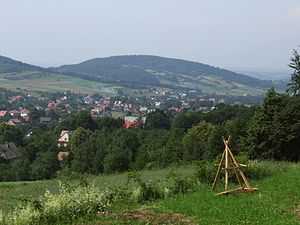West-Beskidian Piedmont
From Wikipedia, the free encyclopedia
| West-Beskidian Piedmont | |
|---|---|
 Wiśnicki Foothills, southern Poland | |
| Highest point | |
| Peak | Skalka |
| Elevation | 964 m (3,163 ft) |
| Coordinates | 49°33′12″N 18°17′54″E / 49.55333°N 18.29833°ECoordinates: 49°33′12″N 18°17′54″E / 49.55333°N 18.29833°E |
| Naming | |
| Native name |
Pogórze Zachodniobeskidzkie (pl) Západobeskydské podhůří (cs) |
| Geography | |
<div style="padding:2px 2px 5px 2px;> | |
| Countries | Czech Republic and Poland |
| Regions | Moravia, Czech Silesia and Lesser Poland |
| Parent range | Outer Western Carpathians |
| Borders on | Western Beskids and Central Beskidian Piedmont |
The West-Beskidian Piedmont (Czech: Západobeskydské podhůří, Polish: Pogórze Zachodniobeskidzkie) is a geological region of the northeastern Czech Republic extending into southern Poland. The relatively modest foothills are considered part of the Outer Western Carpathians.
Subdivision
The West-Beskidian Piedmont consists of four subranges (from west to east):
- Silesian-Moravian Foothills (Czech: Podbeskydská pahorkatina, Polish: Pogórze Śląsko-Morawskie)
- Silesian Piedmont (Polish: Pogórze Śląskie)
- Wieliczka Piedmont (Polish: Pogórze Wielickie)
- Wiśnicz Piedmont (Polish: Pogórze Wiśnickie)
See also
| Wikimedia Commons has media related to West-Beskidian Piedmont. |
| ||||||||||||||||||||||||||||||||
This article is issued from Wikipedia. The text is available under the Creative Commons Attribution/Share Alike; additional terms may apply for the media files.
